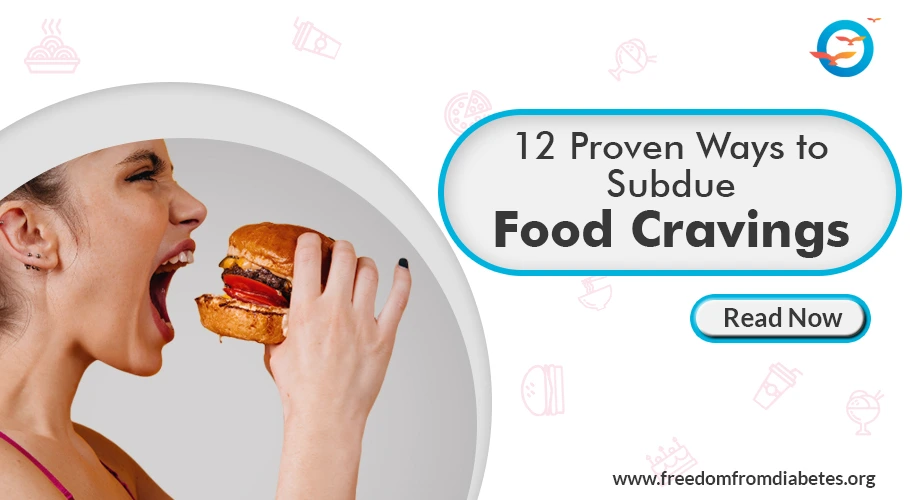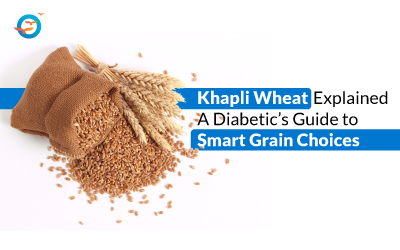12 Proven Ways to Subdue Food Cravings

What Are the Best Strategies to Control Food Cravings?
Every single human being experiences food cravings at some point or another. Sometimes these are triggered by very real hunger, and as such, should be assuaged as soon as possible. However, often these irresistible urges to ear are prompted by chemical/hormonal reactions in the body.
For instance, indulging in a high sugary snack brings an almost immediate endorphin (chemicals like serotonin and dopamine) surge that quickly plunges and creates a desire to repeat the endorphin experience. Repeatedly.
If one gives in to the urges, there can be only one result: an increase in body fat, which will ultimately lead to obesity. The good news is that while it isn’t easy to kick the habit of indulging in sugary/carb-rich foods, once you do manage to break the habit, the cravings usually disappear.
1. Beware of Fad Diets
Diets by their very nature are restrictive. You might initially feel that the diet/s will change your eating patterns and help you grow stronger, healthier, thinner, etc. But invariably, within days or hours, even, you will begin to suffer ever more demanding cravings for the very foods you’re restricted from eating.
In fact, studies found that people on diets are more likely to suffer food cravings than those who are not on any diet. Not just that, the cravings are also usually more intense in the dieter. There are several studies that show that food deprivation only increases cravings for banned foods. This brings us neatly to our next point: eat sufficient calories.
2. Eat Sufficient Calories
There is a proviso here, the calories should come from nutrient-rich, healthy, filling foods, rather than fatty, sugary, or savoury foods. Food is the fuel your body needs to produce energy. Depriving it of foods it has grown familiar with can induce cravings for those specific foods. Thus, ensuring you’re refueling with nutritious food and not overly restricting your body’s food needs can help decrease food cravings.
3. Tank Up on Protein and fibre
Eating more protein has been found to keep hunger pangs at bay for longer. Protein takes longer to digest, keeping your body feeling full for longer. Fibre slows down the absorption of glucose. Fibre also improves digestive function, makes for a healthy gut biome, and avoids bloating, flatulence and constipation. Eating high-fiber foods induce a feeling of satiety and reduces food cravings.
So don’t skip your high-protein, high-fiber foods during meals. Studies show that skipping meals leads directly to cravings for unhealthy foods like salty snacks or sugary foods full of empty calories (with low-to-no nutritive content).While consuming protein, make sure you choose healthy food sources, like beans, sprouts, legumes and lentils. All of these are high in protein as well as fibre and a ton of other essential nutrients.
4. Stay Hydrated
You’d be surprised how often the body misinterprets thirst signals from the brain for food cravings. There is a way to differentiate, though. When this craving hits, don’t reach for the fridge. Instead, chug down a small glass of water and wait. If the cravings dissipate or disappear, you know you were just thirsty.
Another way water helps reduce weight is if you drink a couple of cups of water immediately before meals, especially if you’re on a restrictive meal plan. The water fills you up and reduces the quantity of food you end up consuming. A great way to stay hydrated and keep off the pounds.
5. Stay Active Daily: Exercise Tips
There is no denying that our lives get more sedentary by the day. Two of the twin negatives of urbanisation are unhealthy eating habits and sedentary living. Where our forefathers spent time on their feet—be it in the fields, shopfloor, or worksites—we now sit at our desks, often with a sugary snack or beverage for company.
Getting up and walking around even for 15 minutes at a time can have a wonderful effect on your well-being. As an added benefit, you will see your cravings disappear too. Instead of just walking, you could give anti-gravity exercises a go. Staircase climbing is the easiest. Just try walking up the stairs instead of taking the lift. Or you can give the Nitric Oxide Dump a go.
It takes less than five minutes for a session and the results last for hours. At FFD, we take exercise very seriously indeed. Rather than just walking endlessly, we strongly recommend Anti-Gravity Exercises (staircase climbing being the most accessible for all) and Nitric Oxide Dump.
6. Use Apples to Subdue Cravings
One of the problems with cravings, is that it isn’t easy to tell if what we’re experiencing is just a craving or the real thing. Apples—or any fruit—can help. Here’s how: We all know that apples are good for us and sweet/salty snacks are bad. Yet given a choice, people invariably reach for the unhealthy, calorie-heavy-nutrition-light snacks. You can use this to distinguish between a real need for food and artificial craving.
So the next time you experience a food craving, try asking yourself if an apple would do instead. If the answer is no…there you go. It’s just a craving. Which you can subdue with a brief exercise session or a glass of water. If the answer is yes, go ahead and crunch into the apple. It’s good for you.
7. How to Manage Stress?
There’s a valid reason why empty-calorie foods like ice cream and fried snacks have won the sobriquet of ‘comfort food’. Consuming them feels good when we are stressed. That’s because stress triggers hunger cravings too, prompting people to reach for these unhealthy foods. If you eliminate stress, you also eliminate the food cravings. Some ways to do this are:
- Take regular breaks from working
- Breathe deeply in and out and recenter your mind
- Take up yoga or tai chi
- Practice meditating
At FFD, one of the four protocols on which our programs are based is Inner Transformation. Using a variety of guided techniques, participants are taught to release long pent up stresses. The results are simply amazing and result in long-term behavioural changes that let participants re-invent themselves and their lives.
8. Diet Plans with Cheat Meals
There’s a reason cheat meals have a place in almost every diet plan. Steadfastly damping down on cravings is not just difficult, it can have real, negative consequences. Whereas, if you have a ‘planned’ cheat meal waiting for you, it’s easier to ignore cravings.
‘Cheating’ with an occasional restricted treat or a meal or even an entire cheat day, gives you a boost and the resilience to stick to your diet plan.
9. Chew on Some Gum
Similar to the ‘apple-snack’ trick, reaching for a stick of sugar-free chewing gum also helps reduce cravings. Some studies show that this may be a result of the act of chewing. Sugar-free chewing gum is a much better alternative to high-carb/fat, high-calorie snacks.
The act of chewing also activates your salivary glands, warding off dryness in the mouth, keeping bacteria at bay, and improving oral hygiene. Increasing saliva production has a neutralising effect on bacteria and acidic secretions of the bacteria. Thus it protects against caries and dental erosion
10. Avoid Hunger
When one goes on a diet, one necessarily reduces calories—calories that the body is accustomed to receiving. This leads to feelings of hunger. And, as we have seen and, no doubt, experienced, when we’re hungry we reach for the sweet-salty stuff that does nothing for our waistline.
The trick is to avoid this feeling of hunger coming on at the outset. The easiest way to do this is to structure your mealtimes and stick to the timetable. This will effectively train you body and brain to understand that there are specific times for meals during the day. In a matter of days, you will notice your cravings disappearing and your hunger pangs will kick in around the set meal times.
11. Foods for Diabetes Control
Your blood sugar levels are directly influenced by the time since your previous meal—and its composition. If you ate a meal high in sugar or simple carbohydrates, chances are you will feel hungry again soon.
Your cravings will kick in and with it the desire for stuff like French fries, chocolate cake, etc. There is real evidence to show that people with stable blood sugar levels are less likely to experience food cravings. Also, cravings tend to reduce with better management of blood sugar.
Consuming healthy foods, which are high in fibre, macronutrients, vitamins, and micronutrients, at specific times through the day helps ward of insulin insensitivity. You will be less likely to crave unhealthy foods, which means a reduced risk of becoming overweight, and a lower risk of contracting metabolic disorders, like diabetes.
12. How Lack of Sleep Affects Cravings
Studies have conclusively linked unhealthy food cravings with insufficient shut-eye. Lack of sleep is known to stimulate the frontal cortex and amygdala. Recent studies show a key connection between these areas in the brain and the regulation of our appetite. Lack of sleep, worryingly, raises the risk of contracting disorders like diabetes, heart damage, and anxiety-depression.
Aim to get at least seven hours of deep, undisturbed sleep every night and you’ll feel more energized, healthier, and less prone to food cravings. Managing food cravings helps us maintain a healthy weight range and avoid the risk of diabetes, high BP, heart disease, etc.
FFD’s weight loss programs and Diabetes Reversal Programs incorporate many of these techniques to help program participants reach and sustain their health goals.
Read more about Superfoods for Diabetes Reversal, visit our blog.
FAQs
What causes food cravings?
Food cravings can be caused by hormonal changes, stress, lack of sleep, or a diet low in nutrients.
Do fad diets increase food cravings?
Yes, restrictive diets can make you crave the foods you’re avoiding.
How can eating enough calories help?
Eating enough nutritious food keeps you full and reduces unhealthy cravings.
Why are protein and fiber important?
They keep you full for longer and help control hunger and cravings.
Does drinking water help with cravings?
Yes, sometimes thirst is mistaken for hunger. Drinking water can reduce cravings.

